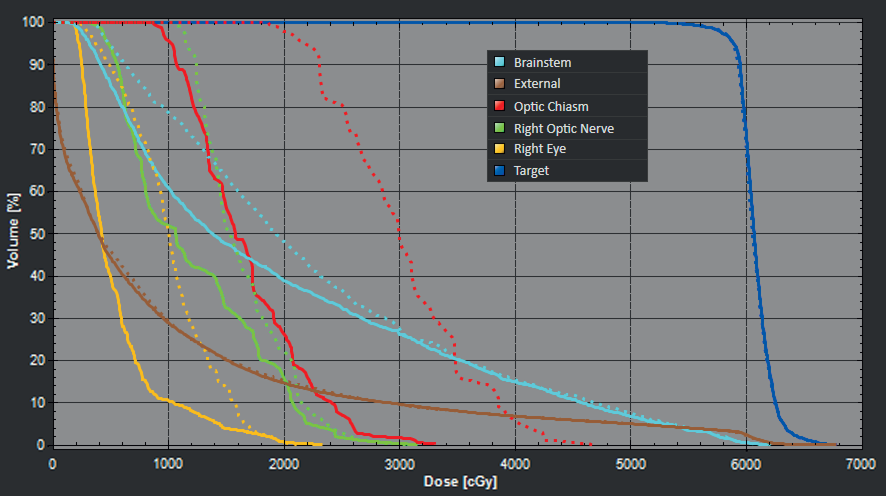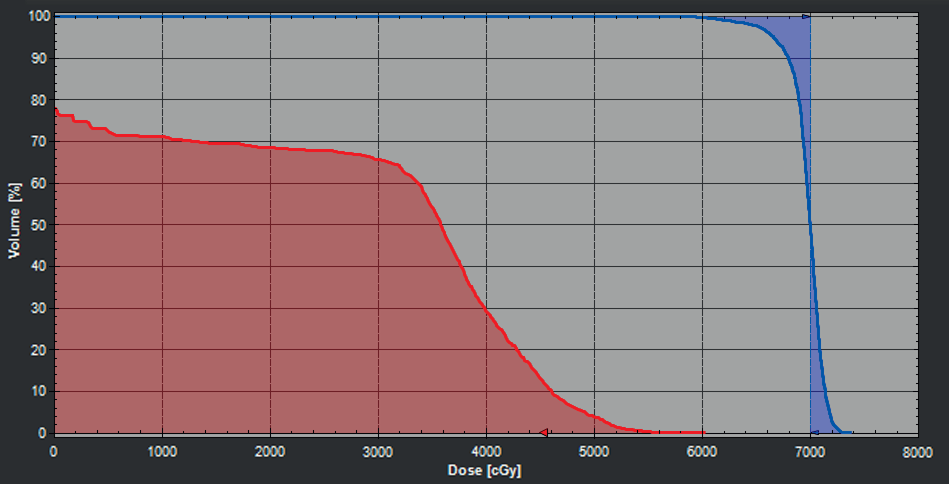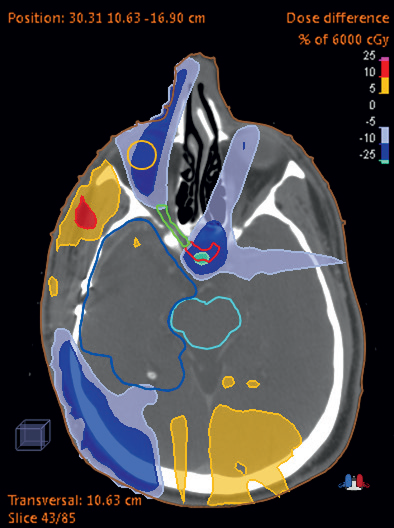

REDUCE ORGAN AT RISK DOSE IN RAYSTATION
Treatment planning is typically performed towards fulfillment of a set of clinical goals. Once a plan satisfying the clinical goals has been found, there are often aspects of the plan that can be further improved upon. To simplify procuring the improvements, RayStation implements the Reduce Organ at Risk (OAR) dose functionality, which uses the current plan as a reference and aims to improve upon the treatment plan without compromising any goal. Reduce OAR dose automatically reduces the OAR doses as much as possible while the dose distributions of all targets and OARs are constrained not to deteriorate compared to the reference plan.
The shaded areas in Figure 1 illustrate the admissible DVH curves under these constraints. The functionality is available for intensity-modulated radiation therapy (IMRT), volumetric-modulated arc therapy (VMAT), and pencil beam scanning (PBS). Possible use cases of the method include improving upon plans before delivery to ensure consistent plan quality, education of treatment planners, and assurance that the quality of treatment plans is as good as possible.

USING REDUCE OAR DOSE
Reduce OAR dose is a one-click post-processing method that is applied after the conventional planning. It is started from a button in the optimization controls in RayStation, as shown in Figure 2, and can be used whenever Continue optimization can. Once the button is pressed, the following steps are performed:
1. The dose distribution of the current plan is set as reference dose.
2. The ROIs are partitioned into a group of target ROIs and a group of OARs on the basis of the current user-specified optimization problem.
3. For each OAR, an objective constituent penalizing its mean dose is introduced.
4. For each OAR, a constraint disallowing doses above the reference dose is introduced.
5. For each target, a constraint disallowing dose distributions that are less uniform than the reference dose distribution is introduced.
6. The optimization problem is solved by optimization of the machine parameters (leaf positions and control point weights for IMRT and VMAT and spot weights for pencil beam scanning).

OAR dose button. It is enabled whenever Continue is.
Reduce OAR dose determines which structures to consider from the user-specified optimization problem as follows: an ROI is grouped as a target if it has an objective function or a constraint of target type (a function that aims to increase the dose from zero), and as an OAR if it has an objective or a constraint of OAR type (a function that penalizes doses above some level) and is not a target.
Further information and technical details can be found in Fredriksson [1].
EXAMPLE PATIENT CASE
Reduce OAR dose is exemplified by application to a brain case. The DVHs prior to and after Reduce OAR dose has been applied are shown in Figure 3. The figure shows that Reduce OAR dose does not change the target DVH, but that the OAR doses are reduced. The dose difference between the plan resulting from Reduce OAR dose and the reference plan is shown in Figure 4.
Improved DVHs

Dose difference

CONCLUSION
Reduce Organ at Risk dose is a one-click post-processing functionality in RayStation that can easily be applied after conventional planning whenever Continue optimization can. It enables treatment planners to consistently reach plans that cannot be improved upon.
REFERENCES
[1] A. Fredriksson. Automated improvement of radiation therapy treatment plans by optimization under reference dose constraints, Phys. Med. Biol. 57(23):7799-7811, 2012.
For more information or to see a demo, contact sales@raysearchlabs.com